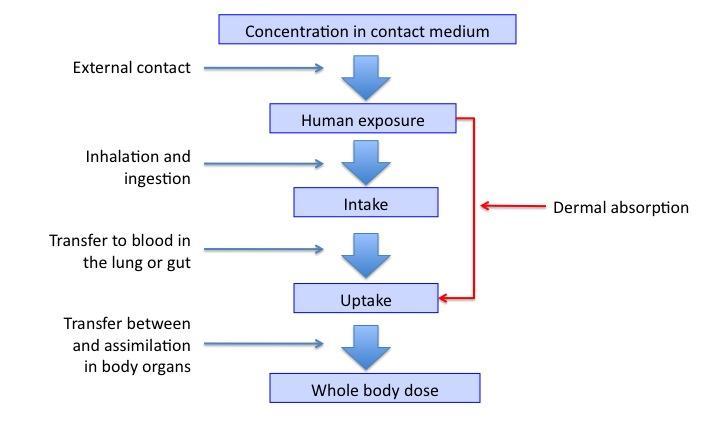Exposure, intake and uptake in IEHIAS
- The text on this page is taken from an equivalent page of the IEHIAS-project.
The exposure-dose chain
When an individual comes into contact with a contaminant in the environment, a chain of processes is set in place, which culimnates in all or part of the agent being absorbed into the body (see Figure 1, below). The efficiency of these processes has major significance in terms of health impact, for it is only when the agent reaches a sensitive (target) organism, that adverse responses usually occur. This poses substantial challenges for impact assessment, for it means that impacts are not dependent only on the levels of ther agent in the environment, nor the amounts that people encounter there, but also on the efficiency with which they take in and absorb the agent. All these factors vary between individuals, as a result of individual differences in personal characteristics and behaviour, leading to substantial variations in risk across the population. For the same reason, different individuals may respond very differently to changes in environmental concentration generated by a policy intervention. Understanding, and quantifying, these variations is therefore important if integrated assessments are to provide reliable estimates of health impact.
Figure 1: Interlinkage of key exposure terms
Definitions
As Figure 1 indicates, exposure, intake and uptake are closely related links in the process by which individuals come into contact with, and subsequently absorb, environmental contaminants.
Within this framework, exposure can be defined (IPCS 2004) as:
the contact between an agent and a target, with contact taking place at an exposure surface over a certain exposure period.
As such, it comprises the time-weighted average concentration of an agent with which a person or population comes into contact in different microenvironments and activities. It can be represented as "the product of concentration, time and duration or (rate of transport of the toxicant)" (Paustenbach 2000). This can be expressed mathematically as:
(Ott et al. 2006)
where:
E = the exposure to an individual of pollutant X (summed over k microenvironments);
Ci= the concentration in the ith microenvironment;
ti = the time spent in the microenvironment;
T = the total amount of time of interest;
Intake comprises the next step in the process. Following, again, the definitions established by the IPCS (2004) it can be specified as the:
amount (mass) of an agent crossing an outer exposure surface of a target without passing an absorption barrier, i.e., through ingestion or inhalation.
Absorption barriers in this context include the skin, lung surface and intestinal tract.
Entry through such a barrier, into a body organ, is referred to as uptake, and the amounts absorbed into the organs as a consequence are referred to as the dose.
From the same framework, several other key concepts arise:
- Exposure pathway is the environmental route from the emission source to human contact.
- Exposure routes or routes of entry define the boundaries that are exposed (inhalation/lung, ingestion/gut, dermal/skin).
- Total exposure is the sum of all exposures to an agent over all pathways and routes of entry.
- Population exposure is the sum of all individual exposures;
- Target organ dose is the amount absorbed within a specific organ in the body, which shows some form of toxic response.
- Whole body dose is the sum of the absorbed quantities (allowing for transfer between organs and excretion).
References
- IPCS 2004 Risk assessment terminology. Part 2: IPCS Glossary of key exposure assessment terminology. Geneva: World Health Organization.
- Nieuwenhuisen, M.E. 2003 Exposure assessment in occupational and environmental epidemiology. Oxford: Oxford University Press.
- Paustenbach, D.J. 2002 The practice of exposure assessment: a state-of-the-art-review. Journal of Toxicology and Environmentl Health. Part B. Critical Reviews. 3 (3), 179-291.
- WHO 2005 Principles of characterizing and applying human exposure models. Harmonization Project document no. 3. Geneva: World Health Oganization.


